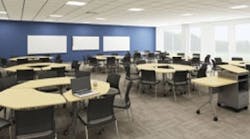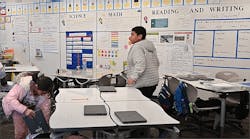Preparing tomorrow’s leaders is a responsibility we all share. In the face of global demands, a renewed sense of urgency exists about the preparedness and capabilities of today’s young adults. It has spawned a debate about education, reform and planning effective learning spaces.
Effective classroom design is a crucial element in learning. Additionally, learning opportunities can be extended well beyond the classroom to create entire learning environments that support student success. Despite the transformations necessary to equip students with 21st-century skills, planners and decisionmakers at education institutions continue to design classrooms and campuses that reflect outdated modes of teaching.
Exploring educational space design using a "learning per square foot" concept can improve student success, creating a community of learning and strengthening our country’s competitive position.
The case for change
Concerns over the United States’ educational system have reached critical mass. Questions about our ability to compete in a global marketplace have positioned education squarely under the microscope. The U.S. labor market faces a widening gap between the skills of our future leaders and projected labor needs.
Although few would argue that changes in education are needed, the consensus is that change is not occurring fast enough. New models of pedagogy, or teaching practices, are beginning to appear, but advances in technology and the resulting learning styles of today’s students have outpaced the changes in teaching methods. Greater action is needed urgently.
It’s "Time to Paradigm"
The need to transform education has a profound effect on the planning and use of space. Conversely, classroom design also can serve as an agent for effective changes in education, supporting a diversity of learning styles, as well as new teaching styles.
Opportunities for learning go beyond the classroom, and good planning and space design can help harness them. It’s important to integrate planning for both informal and formal spaces across a school or campus in an effort to establish an entire learning ecosystem, one that enables learning to take place anytime, anywhere.
Educators, planners, designers and students have a unique opportunity to collaborate on the adoption of new design principles—principles that go beyond the familiar practice of designing space by headcounts. These initiatives instead enable new ways of learning and reflect the trend to more student-centered, collaborative and group learning.
If students-per-square-foot formulas no longer support effective learning, what is the alternative? Could the concept of "learning per square foot" replace archaic mathematical formulas to help drive a contemporary and successful learning environment? What would a learning-per-square-foot space design plan look like, and how could it be measured?
Linking Pedagogy and Space
Creating great learning environments to support 21st-century skills would be simpler if every school, institution, classroom, teacher and student were the same, but education is an extremely diverse field, and no single approach to creating optimal classrooms or campuses exists.
Compounding the complexity is the expectation that good education be dynamic. In response, classrooms may be in constant flux to reflect the pace of change and interchange. Designing flexibility into an education space therefore is crucial.
The more dynamic the pedagogical approach, the greater the need for dynamic space. The less that students need the physical limitations of bricks and mortar to learn, the more flexible the facility planning must be. Curriculum must drive planning.
Efforts to initiate active and collaborative learning often are forced into traditional classroom designs. Those efforts now are beginning to transform those traditional spaces into flexible environments that can accommodate both diversity and density.
Revitalizing to Redefining
Redesigning classrooms often requires reconfiguring walls as well as furnishings and making those spaces available for multiple uses. Designs driven by new pedagogy may include a variety of spaces for individual work, small-group work, large-group work, lectures, presentations, breakouts and interaction with faculty.
Yet, truly optimal learning environments must be more than revamped classrooms that support laptops and promote collaboration with other students. To truly shift the educational paradigm, learning spaces also must reflect a network of connected places outside the classroom. Where learning can flow from one space to the next, and a sense of community is fostered.
The right design will create a community of learning in every square foot and leverage space for "socially catalytic" interactions, areas where students and faculty can meet informally or where students can work together on projects:
•Commons areas historically have served as a place for students to gather for conversation and social activities. Now, when students meet in a commons area, they’re likely to bring laptops, smart phones and other electronic devices that enable them to socialize and pursue academics at the same time. Mobility and ease of furniture reconfiguration is critical for leveraging the learning opportunities that common spaces afford.
•In corridors and along walkways, students and faculty spontaneously continue classroom dialogue and explore ideas. Adding chairs, tables and whiteboards in such "neutral" spaces promotes the opportunity for continued student engagement.
•Areas directly outside academic offices also provide opportunities for continued collaborative learning. The addition of tables, chairs and whiteboards encourages students to work on projects. Interaction with faculty encourages students’ independent involvement in learning.
•Informal nooks, monumental stairwells, landings and off-elevator spaces all serve as potential learning spaces. Planning and maintaining areas where students casually bump into one another may support impromptu student engagement and foster a community of learning. Comfortable seating may become an invitation to relax and keep learning.
Changing Measurements, Parameters, Mindsets
New design principles in education require a completely revised approach to reconfiguring learning spaces and measuring success. But how do we drive toward a learning-per-square-foot mindset and replace outdated students-per-square-foot standards? The concept is so entrenched in educational space planning, yet it seems to be contrary to the academic excellence that’s needed in the 21st century.
The solutions for replacing irrelevant design formulas certainly will be as varied as the students, teachers and curriculum across the country. Yet, the formulas for creating optimal learning spaces will benefit given the following considerations:
•Plan and design holistically, incorporating informal learning spaces. Classrooms are not the only areas that qualify as "learning" spaces. Non-classroom areas can and should be part of the education equation. Facilities and institutions must maximize educational opportunities by considering every square foot on campus as a potential learning space, and explore ways to connect each area of learning.
•Enable and support technology. Technology has transformed our world and shaped our students—24/7 access to technology is how the digital generation learns. It now also must be leveraged when faculty teach.
•Deliver versatility. Mobility, flexibility and adaptability are recurring themes behind the evolution in space design. From furniture to walls, the right choices easily move beyond the classroom and beyond today to ensure future adaptation and long-term investment value.
•Advance environmental objectives. Schools want to select interior products based on sustainable materials, manufacturing processes and indoor air quality. The desire to go green enters into the planning equation, as much for overall environmental reasons as for ensuring safe and healthful campus environments.
•Redefine success. Success is defined by student metrics. So long as administrators, teachers, facility planners and students acknowledge the changes in the educational environment, together they can commit to developing a new approach to space planning and design that is supportive of student success. Consideration for a "learning per square foot" approach that includes both formal and informal engagement may be a good first step.
In the end, every project involving space should be considered an opportunity to create a learning-centered environment. Teachers must be willing to explore and adopt new concepts in education. Academic leaders must leverage education trends to transform schools, develop faculty and ensure student success. Students must share their insights about how they learn and what constitutes ideal learning environments. And architects and designers must be prepared to deliver innovative spaces that fuel a 21st-century learning process.
Kiefer is Vice President, Education Market, at KI, Green Bay, Wis. She can be reached at [email protected].



